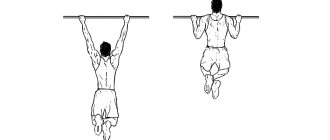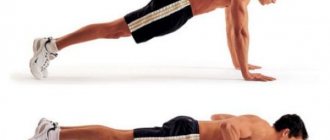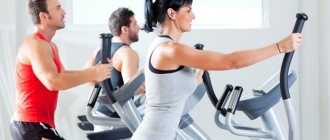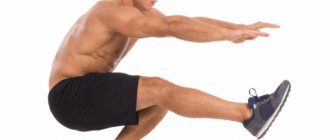0
(0)
The push-up exercise has been around for hundreds of years.
This is an excellent training exercise for most muscles in the body and does not require any equipment. It can be done both on the street and at home. It does not require additional equipment and is suitable for beginners. Today you will learn a good program for push-ups at home.
In this post, I'm going to break down this amazing exercise and show you not only how to do it effectively, but also how to develop your own push-up workouts to get to that magical 100 reps in one set and introduce you to a program like 100 push-ups in one set. 6 weeks.
Muscles used during push-ups
Push-ups are a full-body exercise that works many major muscle groups, including:
- The pecs are your fan-shaped pectoral muscles and are heavily used in all floor push exercises.
- The triceps is another pushing muscle attached to the back of the arm. The triceps work hard to straighten the arm. So if you don't fully straighten your arm, you won't get the most out of these muscles.
- The deltoids – the shoulder muscles play a large role in all pushing exercises, but also in stabilizing the upper body to maintain balance during the exercise.
- The serratus anterior muscle is a muscle on either side of the rib cage that attaches to the shoulder blade and prevents it from flailing during movement. Well-developed serratus anterior muscles look like a bunch of bananas just under the armpit.
- Abdominal Press – Push-ups involve the work of the core muscles. From a push-up position, gravity forces your hips toward the floor, and it's your core muscles that prevent this from happening. You can think of the push-up as an exercise with a loose, moving board that you support with your hands.
- Gluteus muscles – The gluteus maximus muscles are responsible for stabilizing the hip muscles and the entire body. When you hold your body in a straight push-up position, these muscles help keep your hips extended in line.
- The latissimus dorsi is the large pterygoid muscle on the back of the body that runs from the arm down to the buttocks. They not only create internal rotation of the arm, but also help stabilize it all the way down to the buttocks!
- Secondary Muscles – The push-up uses many more muscles, which also help with proper body alignment and stabilization. The back of the body is actually more involved than you might imagine.
Safety and precautions
You shouldn't do push-ups, much less a 100-push-up program, if you have a shoulder, wrist, or elbow injury. Talk to your doctor or physical therapist to find out if this exercise is appropriate. If you want to protect your wrists, you can place your hands on dumbbells to keep them in a neutral position. If you feel pain in your shoulder during push-ups, or hear a clicking sound in your shoulder, finish the push-up exercise.
If there are no contraindications, do not forget to do a mandatory warm-up of the whole body before each workout.
If your physical fitness is weak or you have just started on the path to a healthy lifestyle, then I advise you to read the article on how to learn to do push-ups, it will help you understand the basic techniques and principles for performing the exercise safely.
Floor push-ups: 100 push-ups program
The program for doing 100 push-ups in 6 weeks is not particularly varied. It involves performing only classic push-ups from the floor. Their technique has been familiar to us since school, but it wouldn’t hurt to remember it again. It is recommended to rest no more than a minute between approaches.
Let's look at what a 100 push-up training program would look like. In the standard version, it is divided into six periods, since it assumes achieving results within six weeks. The schedule may vary depending on your fitness level and health status. If you are completely healthy, and the initial test showed fairly good results, work out on the line where the number of repetitions is highest. But for beginners and people of age or with certain health problems, the first line is more suitable. The load can always be increased, and there is no need to rush with it in order to minimize the risks of all sorts of negative consequences.
A standard table on how to do 100 push-ups looks like this:
There is another method for doing 100 push-ups in one approach. It is designed for a longer period of time, namely 12 weeks. This is a good option for those who are completely new to push-ups - starting with a minimum load, as a result you can slowly but surely achieve the coveted hundred.
With such a smooth approach, the body does not experience enormous stress, so even a beginner with a minimal level of training can strengthen the muscles without any risks, preparing them later for intense exercise. Every day more repetitions are added, the number of approaches changes. As a result, after spending three months, you will be able to do a hundred or more push-ups in one approach! After this, mono will switch to another popular program, increasing the load, or simply maintain the result stable, repeating the scheme of the last two weeks.
If you want to do 100 push-ups, the workout program you presented will help you do it. Try to never stop there. If training with regular push-ups seems too boring to you, diversify them with other variations. There are reverse push-ups, clap push-ups, fist push-ups and finger push-ups, which are mainly used by male martial artists. A very difficult, although effective option is one-arm push-ups. Since all the weight will be transferred to one of the hands, its strength must be very developed. It is important to be able to listen to your body. Increase the load gradually. This applies to both the number of repetitions of the exercise and its more complex variations - it is better to act slowly, but confidently and safely.
How to do perfect push-ups?
Let's look at the push up itself and see how to properly perform the push-up exercise.
Hands
Hand position can vary, and generally the closer your hands are to each other, the more triceps are recruited.
- The wider your arms, the more you use your shoulders.
- We'll talk more about the different types of push-ups later.
- For now, let's keep our hands shoulder-width apart and directly under our shoulders. Your fingertips should be pointing forward.
- If you struggle with painful wrists, then you can try forming a fist and doing fist push-ups.
- Use a mat or towels under your fists to make it more comfortable.
- Another option to avoid wrist pain is to try using push-ups where your hands are in a different position.
Legs
Keeping your feet together will better engage your core muscles, but if you find yourself in an unsteady or uncomfortable position, move your feet to a comfortable distance.
You may have seen people doing push-ups with one leg over the other or with their legs in the air, these variations place less stability on the legs and challenge the core and shoulder muscles to stabilize them more during the movement.
shoulder blades
During a push-up, your shoulder blades will want to spread their “wings” or stick out back. Winged shoulder blades are very common and often come down to weak serratus anterior muscles, so it's important that you work hard to keep your back flat as you move.
When you think about the middle of your back between your shoulder blades, you want to actively push that area up and not allow that part to sag down when you get tired. Make sure you finish the top of the movement by pushing upward through the middle of your back.
Smooth body
In the starting push-up position, there should be a straight line from head to heels. You can test this position by asking a friend to place a broom along your back, and based on their feedback, you can adjust your position accordingly.
Stabilizing the body, tightening the abdominal muscles and contracting the buttocks should bring everything into alignment.
If your posture changes during the exercise and your lower back begins to arch, then it's time to stop. A arched lower back is usually a sign of core weakness, and you may want to work on strengthening exercises first before moving on to push-ups.
Head
A good rule of thumb is to look down directly in front of your hands.
Keep your head still throughout the movement, and you should not sway during the exercise, even when you are tired.
Elbows
The elbows should not be extended during the down and up phase of the movement. You never push anything with your elbows out, so now is not the time to start. Keep your elbows close to your body for a more favorable shoulder angle.
During the downward phase of the push-up, press your hands into the floor towards your body, this will activate your latissimus dorsi muscles down the back and sides of your body. You should feel the muscles under your arms activate as you pull yourself down towards the floor.
At the top of the movement, you should aim to straighten your arms. Don't pull your elbows back, but make sure they are straight to activate the triceps muscles on the back of your arms.
Push-up speed
You can perform push-ups at different speeds, but I would recommend a controlled pace of 2 seconds down and 2 seconds up. Don't let your body fall to the floor.
Pull your body down under control. It's during the downward phase that you really gain the most strength, so don't miss half the exercise by falling to the floor.
As you become more advanced at the push-up, you can slowly lower yourself and rise back up again with a big bang, but to begin with, you'll want to focus on technique and control the movement.
Push-up depth
Your goal is to achieve a 90 degree angle at your elbow. If you go much deeper than required, you increase the risk of soft tissue and ligament damage.
If you need help determining the depth of the push-up, you can place a rolled-up towel under your chest and aim to touch it with your chest on each rep.
Breath
As you go down, take a deep breath, and as you go up, exhale.
When performing more powerful pushup variations, such as clapbacks and plyo pushups, you may need to hold your breath for a split second to get maximum core tension.
The reason you need to hold your breath is because the diaphragm acts as a secondary stabilizer of the core muscles, so it is impossible to simultaneously breathe consistently and perform the exercise with maximum effort.
Types of push-ups - table
In practice, the preparation of a push-up program depends on the athlete’s level of physical fitness - and the ability to perform the classic version of the exercise. It is recommended to carry out training 3-4 times a week, aiming to reach 100 total repetitions in various variations of push-ups:
Knee push-ups
The easiest push-up variation to perform. Suitable for beginners - and especially girls. Starting position - arms extended, knees on the floor, abs tense. As you inhale, slowly lower yourself down, and as you exhale, push up from the floor as high as possible.
Stand push-ups
By using an arm rest, the load on the pectoral muscles is reduced, making this type of push-up easier. In addition, the lower chest and triceps are actively involved in the work. When performing push-ups with a stand, it is recommended to keep your hands at a close distance from each other.
Classic push-ups
Starting position - arms extended in front of you, abdominal, core and leg muscles tense, body weight distributed evenly. As you inhale, slowly lower yourself down, without arching your head and making sure that your stomach is slightly retracted. As you exhale, return to the starting position, feeling the work of your chest muscles.
Push-ups with wide arms
Remember that the width of your arms can make push-ups more difficult or easier. Wider placement of the arms allows the outer part of the pectoral muscles to be involved in the work, giving the chest additional volume. However, when performing the exercise, your elbows should not go to the sides.
Push-ups with a footrest
While using a hand rest makes doing push-ups easier, using a foot rest makes the exercise more difficult. In addition, the upper part of the pectoral muscles and the muscles of the upper back are actively involved in the work. Go down as low as possible, feeling the stretch in your chest muscles.
Push-ups with alternating leg raises
Push-ups with alternating leg raises allow you to train coordination and balance while strengthening the stabilizing muscles of the core. Lift your right leg up, do a push-up, then switch legs and do the exercise with your left leg raised.
Diamond push-ups
Push-up variation to target the core of the pecs, triceps, traps, and upper back. During the exercise, the hands practically touch each other, forming a triangle (“diamond”) between the thumbs and index fingers. When lowering down, your elbows should not go to the sides.
Push-ups
A more challenging variation of push-ups that increases the load on the muscles of the arms, shoulders and upper back. Also suitable for those who experience wrist pain.
Push-ups with clapping hands
The push-up variation that burns the most calories. Starting position - hands on a low support, body weight is evenly distributed. Push up sharply, lift yourself off the floor and clap your hands. Be careful with your wrists when landing. The exercise requires a good level of physical fitness.
One-arm push-ups
One of the most difficult push-up variations. When doing this, it is recommended to place your legs a little wider than usual - this will help you maintain balance. The free hand can either be located behind the back or touch the opposite shoulder (see the title photo of the material).
Common Mistakes
It's easy to start making push-up mistakes if you're tired or don't have enough strength. Look for them and switch to an easier option if you can't maintain the desired shape.
Sagging in the middle
The most common problem is sagging in the middle, caused by improper core bracing. This may cause back pain. Try doing push-ups on your knees, practicing keeping your torso tight.
Smooth neck
The neck should be in a neutral position, the head should be in a straight line with the spine, and the eyes should be on the floor. If you lift your chin up or lower your head until you can see your toes, you are making a mistake. By the way, good material about the spine, quite generalized but sensible, I recommend it.
Elbow extension
Fully extending your elbows at the top of the movement is a mistake you can make when you get tired and want to rest a little. This puts too much stress on your joints and can lead to injury. Always keep your elbows slightly bent. If you're tired, it's time to rest before doing another set.
Hands too far forward
If your arms are further away than your shoulders, you put more stress on them. Although you can vary how close your hands are to each other to get different effects, your hands should still be under your shoulders.
Limited range of motion
If you're only going down partially on most of your pushups, you're not getting the benefit you need. It's best to switch to an easier modification (such as kneeling or bent-over pushups) that you can do through a full range of motion.
What to do if you can't do a single push-up?
Many people struggle to do just one perfect push-up.
Ladies in particular find push-ups more difficult due to lack of strength. No, I'm not sexist, but men tend to have more upper body strength.
If you find it difficult to do push-ups, you need to regress the movement in order to perform it correctly and avoid injury.
Here's how to do it:
- Wall push-ups: Start by doing push-ups with your hands against the wall, with your feet about a meter away from the wall. When you can complete 20 repetitions, move on to the next level.
- Table push-ups: Perform a push-up with your hands on the edge of a table. Make sure the table is leaned against the wall to prevent it from wobbling. After 20 repetitions, move on to the next stage.
- Push-ups from a chair or stool: the final stage is to lower your hands even lower, onto a chair or stool. Once you can complete 20 reps, lower yourself to the floor.
- Half push-ups: You may not need this step, but if you do, do push-ups from your knees. It is very important that you maintain a straight line from your head to your knees even during this version of the push-up.
Progress in the number of push-ups
Once you perform perfect pushups, you can begin the process of increasing your pushups. You will soon learn the push-up program for gaining muscle mass. Be patient and increase the number of push-ups by placing them in a 5-stage .
Initial assessment
If you want to increase the number of push-ups you can do, you first need to know your starting point.
How many push-ups can you do right now without resting?
Complete as many as you can with perfect form. If your hips start to sag or you lift your hips up to rest, then it's time to stop. Write down this maximum number.
Setting up an initial workout
Now you know how much you can do at one time, you need to create a workout to improve your maximum. I have found that 5 sets generally work best for improving your push-ups. You want to perform twice as many reps as you did in your initial assessment.
So here's how you calculate the numbers for your workout:
- Multiply your maximum number by 2.
- Divide the new number by 5.
- So, if your max was 20: 20 x 2 = 40/5 = 8 reps .
- Perform 5 x 8 reps for a total of 40 reps .
- Rest 60-90 seconds between each set of 8 reps .
This simple formula allows you to create a starting workout that will help improve your push-ups. However, in order to get stronger, you need to progress with each subsequent workout.
6 - week training plan
Thus, you have found out your initial push-up performance. Now let's extend them by 6 weeks and create the right training program so you can get stronger and continue to get results from your workouts at home or outdoors.
Training 3 times a week
I recommend everyone start with 3 workouts per week . Program for Monday, Wednesday and Friday. Remember that you are really getting a strength boost, so you need to rest on these days. More training is not always good for the body. If you find that it's too painful to do the push-up routine when it's time to do the workout, then you can take another day to rest.
Time relax
To improve your push-ups, you need to rest between each set. I have found that 60-90 seconds is a normal rest period.
If you are working with lower numbers, then the rest should be longer, since this is more of a strength training for you.
If you are working at higher numbers the rest may be shorter as it is more endurance oriented.
Change your diet
If you don't need to burn excess fat, you should still include healthy foods in your diet. And don't think that what you eat is not related to the number of possible push-ups you can do.
Why do you think most bodybuilders eat only healthy foods? This is because eating healthy will not only keep your body healthy, but will also help you achieve significantly better results from your workouts.
So, make sure your diet provides you with the nutrients you need (bju). And this is much easier to achieve if you buy quality products and supplements.
Linear push-up program
You'll start with calculations based on your initial estimate. The next method is simple: you simply add one extra rep to each set each workout.
So, taking the example above, if you completed 20 max reps , your first 3 workouts would look like this:
Week 1
| Monday | Set 1 – 8 reps | Set 2 – 8 reps | Set 3 – 8 reps | Set 4 – 8 reps | Set 5 – 8 reps | Total reps: 40 |
| Wednesday | Set 1 – 9 reps | Set 2 – 9 reps | Set 3 – 9 reps | Set 4 – 9 reps | Set 5 – 9 reps | Total reps: 45 |
| Friday | Set 1 – 10 reps | Set 2 – 10 reps | Set 3 – 10 reps | Set 4 – 10 reps | Set 5 – 10 reps | Total reps: 50 |
Week 6
| Monday | Set 1 – 23 reps | Set 2 – 23 reps | Set 3 – 23 reps | Set 4 – 23 reps | Set 5 – 23 reps | Total reps: 115 |
| Wednesday | Set 1 – 24 reps | Set 2 – 24 reps | Set 3 – 24 reps | Set 4 – 24 reps | Set 5 – 24 reps | Total reps: 120 |
| Friday | Set 1 – 25 reps | Set 2 – 25 reps | Set 3 – 25 reps | Set 4 – 25 reps | Set 5 – 25 reps | Total reps: 125 |
So by following this method, by week 6 you will be performing a total of 125 push-ups .
Now recheck your maximum.
You will find that your max should now be around the 60 push-up mark in 6 weeks !
Training program – 100 push-ups in 6 weeks
This program, which is not difficult to implement, will help you achieve your goal of “100 push-ups” in 6 weeks. It may seem impossible for now, but it’s worth believing in; you just need to have half an hour free a day. Before starting classes, take a test to determine your level of preparedness:
Just do as many push-ups as you feel comfortable doing. Just don't lie to yourself. Do everything honestly. Note how many push-ups you have completed. For example, at the beginning I was able to do 25 push-ups. Before starting the program, I would recommend that you familiarize yourself with the program in more detail . This will only take a couple of days. Classes should be held three times a week. It was convenient for me to train on Monday, Wednesday and Friday. I know that many people get level 2 or 3 at the initial stage. This is a very good start. However, if you have achieved level 1, simply start your workout with lighter push-ups. So, let's start executing the program.
1 Week
We start training from the 1st week. You remember your test result. Great. Now you just need to compare the number of push-ups performed with the table below. Let's give a simple example: you performed 10 push-ups and received the second level. This means you need to look at the 2nd column of the table. If your achievements exceeded 20 push-ups, then I would recommend that you go straight to the second week.
Have you made it through the first week and are ready to move on to the second? Well done - well done. I wish you success. If you found this week quite difficult, I would recommend that you repeat it again.
2 week
Let's move on to the second workout. Perform the exercises from the same column that you went through the program in the first week. Just don’t feel sorry for yourself and don’t be lazy. Be sure to take breaks between sets. At the end of the 2nd week, repeat the test. Do as many push-ups as you can, but don't overdo it. This test is needed to determine your level for subsequent training. It needs to be completed a couple of days before the end of the second week.
Don't forget about the test. This number needs to be remembered. Congratulations on completing your second week.
3 week
You are now ready to complete the Week 3 workout. Now I'm sure you're doing a lot more push-ups than you did on the first test. If your number of push-ups:
- 16-20 push-ups – see 1st column
- 20-25 push-ups - see 2nd column
- if you did > 25 push-ups, you’re doing great. You can look at the 3rd column with pride.
If it’s very difficult for you, don’t hang your nose. Many people do only 16 push-ups at this stage. Just repeat the program of the week that you found most difficult. I am sure you will succeed.
4 week
So, exactly half of it has been completed. The fourth training session is ahead. Continue with the program in the same spirit. At the end of this week, take the test you are already so familiar with. Do you remember how it is done? Remember this amount. The test must be completed a couple of days before the end of the fourth week.
Have you forgotten about the test? You are now even stronger than you were when you took the initial test. Remember the number of push-ups you completed.
5 week
A little more and the finish line. Has this week been very difficult for you? I'm just sure that you have overcome all the difficulties. Remember how many push-ups you were able to do in the last test.
- if 31-35 – see 1st column
- 36-40 – see 2nd column
- >40 is simply wonderful. Go to 3rd column
I would like to draw your attention to the fact that from the second day the number of approaches increases, but the interval between approaches and the number of push-ups decreases.
It's time for another test. This week, of course, was very difficult, but after finishing it we need to sum up the result. As before, you should not “tear” the muscles. If you have done more than 45 push-ups, move on to the last week's exercises. If your result is less, repeat the 5th week. You can do anything!
week 6
Here is the finish line. The last week. We can confidently congratulate you. You have come a long way, but still achieved your goal. Keep it up! Remember the last test? If your result:
- 46-50 push-ups - see 1st column
- 51-60 push-ups - see 2nd column
- >60 is simply wonderful. Go to the 3rd column.
At the end of the 6th week, I just want to congratulate you. You can be proud of yourself. Now let's move on to the last final test.
Final test
As you remember, the program is called “100 push-ups.” Let's confirm it. Just do regular push-ups as many times as you can without feeling sorry for yourself or cheating. Experience shows that you are able to do a hundred push-ups in a row! After completing the 6th week, give yourself a couple of days of rest. Eat well and drink plenty of fluids. Try not to put physical stress on your body. So, are you ready to make the final push towards achieving your goal? Take your time, focus on doing 10 push-ups in a row. Breaking 100 push-ups into 10 segments makes the goal more realistic. I'm sure you will succeed.
Earlier articles discussed training programs:
- Training program: 200 press
- Training program: 25 pull-ups
- Training program: 200 squats
Increasing the push-up program
I found the above linear approach to be very effective, but it can be quite boring and the muscle stimulation is not as high as it could be.
Therefore, I prefer to use the wave method, which means that the numbers do not remain consistent from one approach to the next. Here is an optimal example that I compiled personally, based on the same maximum estimate as above:
Week 1
| Monday | Set 1 – 8 reps | Set 2 – 10 reps | Set 3 – 7 reps | Set 4 – 7 reps | Set 5 – 8 reps | Total reps: 40 |
| Wednesday | Set 1 – 9 reps | Set 2 – 8 reps | Set 3 – 11 reps | Set 4 – 8 reps | Set 5 – 9 reps | Total reps: 45 |
| Friday | Set 1 – 13 reps | Set 2 – 15 reps | Set 3 – 12 reps | Set 4 – 12 reps | Set 5 – 13 reps | Total reps: 50 |
Week 2
| Monday | Set 1 – 11 reps | Set 2 – 10 reps | Set 3 – 10 reps | Set 4 – 11 reps | Set 5 – 13 reps | Total reps: 55 |
| Wednesday | Set 1 – 14 reps | Set 2 – 12 reps | Set 3 – 11 reps | Set 4 – 11 reps | Set 5 – 12 reps | Total reps: 60 |
| Friday | Set 1 – 12 reps | Set 2 – 11 reps | Set 3 – 11 reps | Set 4 – 11 reps | Set 5 – 10 reps | Total reps: 65 |
Week 3
| Monday | Set 1 – 14 reps | Set 2 – 13 reps | Set 3 – 16 reps | Set 4 – 13 reps | Set 5 – 14 reps | Total reps: 70 |
| Wednesday | Set 1 – 15 reps | Set 2 – 14 reps | Set 3 – 14 reps | Set 4 – 17 reps | Set 5 – 15 reps | Total reps: 75 |
| Friday | Set 1 – 16 reps | Set 2 – 15 reps | Set 3 – 15 reps | Set 4 – 16 reps | Set 5 – 18 reps | Total reps: 80 |
Week 4
| Monday | Set 1 – 19 reps | Set 2 – 16 reps | Set 3 – 16 reps | Set 4 – 17 reps | Set 5 – 17 reps | Total reps: 85 |
| Wednesday | Set 1 – 17 reps | Set 2 – 20 reps | Set 3 – 17 reps | Set 4 – 18 reps | Set 5 – 18 reps | Total reps: 90 |
| Friday | Set 1 – 18 reps | Set 2 – 18 reps | Set 3 – 21 reps | Set 4 – 19 reps | Set 5 – 19 reps | Total reps: 95 |
Week 5
| Monday | Set 1 – 17 reps | Set 2 – 17 reps | Set 3 – 24 reps | Set 4 – 20 reps | Set 5 – 22 reps | Total reps: 100 |
| Wednesday | Set 1 – 16 reps | Set 2 – 18 reps | Set 3 – 21 reps | Set 4 – 27 reps | Approach 5 – 23 comments | Total reps: 105 |
| Friday | Set 1 – 17 reps | Set 2 – 17 reps | Set 3 – 22 reps | Set 4 – 24 reps | Set 5 – 30 reps | Total reps: 110 |
Week 6
| Monday | Set 1 – 31 reps | Set 2 – 18 reps | Set 3 – 23 reps | Set 4 – 25 reps | Set 5 – 18 reps | Total reps: 115 |
| Wednesday | Set 1 – 16 reps | Set 2 – 35 reps | Set 3 – 24 reps | Set 4 – 26 reps | Set 5 – 19 reps | Total reps: 120 |
| Friday | Set 1 – 17 reps | Set 2 – 30 reps | Set 3 – 25 reps | Set 4 – 30 reps | Set 5 – 23 reps | Total reps: 125 |
You will notice that the total number of repetitions performed is exactly the same as with the linear method, the only difference is the distribution of repetitions across all 5 approaches .
Reviews on the program
- Guys, the program is true, when I started, I did 36 push-ups, I started from week 3, completed the 6th and was able to do 92 push-ups, I just didn’t have enough strength to get to 100))
- The program is working. I started with 50 push-ups, after 3 weeks I did 110 push-ups.
- 15 years ago I was doing a similar program (very similar in principle and timing)… 100 push-ups is real. I could even do 10 push-ups on one hand.
- I was always good at push-ups. But somehow I gave up on all these things and haven’t trained for a long time. I decided to try the program. I did 30 push-ups for the test and started above average in the second week. But, like having done 30 push-ups, it was hard to do the sets, I thought that I would reach the 3rd day of the third week and not complete it... no shit, the third week went like crazy... just ten seconds ago, I successfully completed the 3rd week . I’ll continue and finish anyway) And the muscles are really growing, it seems that in such a short time I’m generally pleased)
Program “100 push-ups”
I have received many letters from people who are interested in the program for 100 push-ups at a time . To achieve this goal, you can use any of the above two programs.
If you want to perform one hundred push-ups, then you will need to do a total of 200 repetitions during your 5 sets . Basically, continue working on any of the above programs for a few more weeks and it will lead you to the desired result.
Beyond regular push-ups (advanced push-ups)
There are many variations of push-ups. As I mentioned earlier, arm position and different leg positions will change both the instability of the shoulder muscles and the demands placed on the shoulders and triceps.
Once you can safely perform 30-50 regular push-ups , you can try some more advanced variations.
Wide push-ups
The wide push-up is a compound exercise that targets the pecs, with less emphasis on the triceps than the standard push-up.
Important details for wide push-ups:
- Even if you do push-ups with wider arms, do them as you would a regular push-up: squeeze your butt tightly and don't let your chest sag.
- Control the position of your elbows. While they won't be pressed against your sides like we recommend in a standard push-up, they should be positioned at about a 45-degree angle relative to your torso.
- Place your hands slightly wider than shoulder-width apart to check your form. Continue to extend your arms by rotating your fingers outward as you become stronger in this exercise.
Finger push-ups
This variation is an excellent option for working with wrist or shoulder injuries. The exercise targets the same muscles as a standard push-up while relieving pressure on the joints.
Important details for finger outward push-ups:
- Make sure to keep your elbows close to your sides as you lower down.
- Don't let your shoulders rise towards your ears. Keep them pulled back and down throughout the entire movement.
Superman push-ups
Let's face it - mastering this push-up will really make you feel like superman. This is a crazy challenge for you.
Important details for Superman push-ups:
- The most important thing in this exercise is to make sure that your body does not sag. Really engage your core and legs to keep yourself upright.
- Start with your hands slightly in front of you and work your way up to a fully extended superman push-up.
How to do push-ups correctly
The correct technique for performing push-ups is as follows:
- Take the starting position in a lying position. The emphasis is on the toes of the feet and palms. The position of the hands is slightly wider than the shoulders (about 5 - 8 cm wider from each shoulder). Palms are parallel to each other. The head, torso and legs form one straight line. The lower back is straight and tense.
- As you inhale, lower yourself down in a smooth motion. Lower yourself until your chest lightly touches the floor. During the movement, the elbows move to the sides.
- With a powerful movement of your arms (while exhaling in sync), return your torso to its original position.










